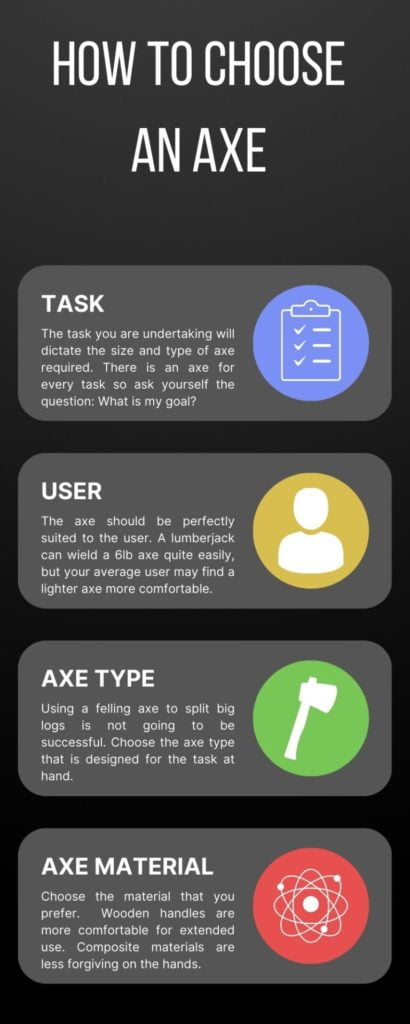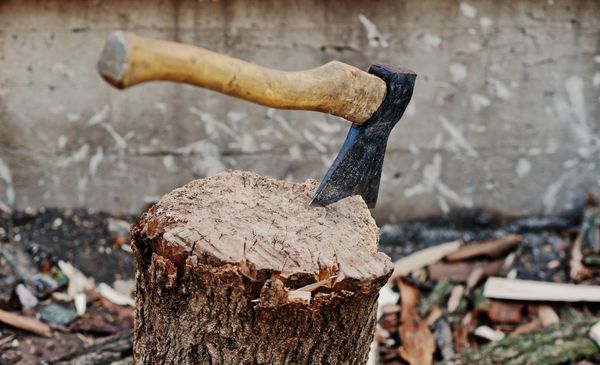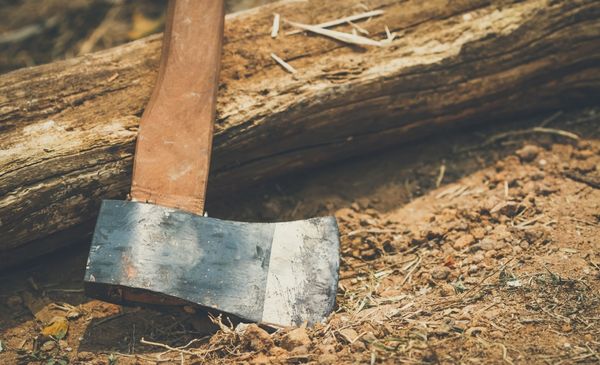Post updated: 25 Feb 2023
With so many types of axe available, it can be pretty hard to know which one is best suited to you and the work that you’re doing. Fear not, this in-depth buyers guide provides you with everything you need to choose the perfect axe.
TABLE OF CONTENTS:
Straight to the point – What size axe do I need?
The job you are doing will dictate the type of axe you will need; Cutting down trees requires a felling axe. Splitting logs for firewood needs a good splitting axe. A small hatchet will serve you best when camping or hiking.
How to choose an axe [Infographic]

There are a few important things to consider before choosing an axe. The obvious one is… what kind of task are you undertaking? The type of axe you choose must be appropriate to the task at hand (More on this later).
As with any purchase, you want to know that for the money you spend you’re gonna get a quality product that will last a good while.
Although price shouldn’t be your main gauge of good quality, it’s best to avoid dirt-cheap axes. They are made with sub-standard materials that will not stand up to any serious work.
Good quality axe heads are made from steel with a high carbon content that won’t chip or dent easily. The best axe heads are hand-forged by brands such as Gransfors Bruk and Hults Bruk in Sweden.

But these are by no means your only options to choose from. Consider these among the best money can buy.
The handles will either be made from wood, a composite such as plastic/fiberglass or less commonly, steel. A nice wooden handle is the classic, but more and more modern axes are using composite material as they are less susceptible to weather and temperature, and have good shock absorbing properties.
So, a fit-for-purpose axe with a good quality steel head and a wooden or composite handle is what we’re after. But that really doesn’t narrow it down much.
Why do you need an axe?
Firstly you’ll want to be clear on why you need an axe in the first place. You might have an old tree in your back yard that you want to cut down. Or maybe you’ve just had a bulk delivery of some logs that don’t quite fit in your fireplace or stove.
Perhaps you’re looking for a handy chopping tool for camping or bushcraft. Whatever task you need to accomplish with the axe should be your first consideration.
What type of axe do I need?
Another consideration is axe type. Felling a tree with small hatchet or a large splitting maul is not gonna be fun. These are for different purposes. Similarly, carrying a full-size felling axe on a hike is probably not necessary. The axe should be fit-for-purpose.
Related Article: 28 different type of axes, and what they’re used for
The axe you choose should be appropriate for the task at hand. Below I’ve listed my recommended axes for a few of the most common activities you may be undertaking.
Cutting down trees
A Snow & Nealley Felling axe or Council Tool Forest axe will do the job nicely. These are long handled and razor sharp for cutting into the trunk of a tree to bring it down. Both are American made axes of fine quality… But the Gransfors American Felling Axe is the big boy in this league!
Log splitting
To split logs you need a different beast. These are nowhere near as sharp as a felling axe because you’re splitting the wood along the fibers rather than cutting into them. For small to medium logs (up to 10 inch rounds) the Hults Bruk Splitting Axe is one of the best out there.
For bigger harder rounds you’ll need a full size splitting tool. It’s a toss between the Fiskars X27 Super Splitting Axe or the Hults Bruk Sarek. Both are serious bits of kit.
Camping and hiking
Something small and versatile is what you’re looking for here. The Helko Werk Pathfinder Hatchet is a great high-end option that will last a lifetime. A more modern option is the Fiskars X7 hatchet – Surprisingly good for the low price and the FiberComp handle is indestructible!
Stuff you might love…
Classic or Modern Axe?
Classic axes
These are generally made from natural materials. Some of the finest axes you can buy have a heritage that dates back over centuries. The Gransfors Bruks Small Forest Axe pictured below is a highly regarded classic that can be handed down to your offspring after a lifetime of use.
This is the ‘axe purists’ main argument against cheaper axes – a quality axe will last a lifetime, maybe even two. So why waste money on re-buying an axe every few years? Buy a great axe, look after it and you’ll never need another!
The common factor across all high quality, high-end axes is 1) the hand-forged, perfected axe head steel which ensures they are neither too hard or too soft and 2) the use of hickory to form an ergonomically shaped handle with the fibers running parallel along the shaft for strength.
There’s nothing quite like the feel of a wooden handle on an axe – It just feels right!
Related Article: How to Sharpen an axe – A Step By Step Guide

Modern Axes
These can be just as effective of course. I’m not saying everyone should buy a Gransfors or a Hults Bruk, far from it. But definitely steer clear of the mass produced hardware store axes – they wont last a day of serious work.
Now when I say ‘modern’ I mean axes with a synthetic handle material rather than wood. This might not be the technically correct way to distinguish between the two but that’s how I think of it.
A good example here is Fiskars. They are a well established brand who make a range of axes that have a hollow ‘FiberComp’ handle and a machined axe head that is permanently set within the handle material such as the Fiskars X17.
My advice for buying a modern axe is go with Fiskars. I bought the X7 Hatchet a year ago just out of curiosity. It’s still one of my essential camping hatchets… and it cost like 30 bucks!
But it does require regular sharpening with a file to keep the edge nice and sharp due to the lower grade steel Fiskars use. Shame, if they upgraded their axe head steel they would be unstoppable… But then they wouldn’t be so affordable!
Stuff you might love…
What size of axe do I need?
The right tool for the right job, right? Chopping down a big tree requires a big axe. Splitting rounds in excess of 2ft across will require a pretty hefty splitting axe or maul.
We also have to take into account who will be doing the swinging. If you’re a big guy you can probably handle a full size splitter, but maybe a mid-sized axe feels better in your hands or perhaps the tree you need to cut down is pretty small.
Lets look at the various sizes of axes and see what they’re good at…
Small axes – Hatchets, Camping axes & Tomahawks
Small axes or hatchets are used mainly for light duties such as splitting kindling for firewood, wood carving, chopping down small trees and cleaning up limbs. These one-handed axes are incredibly versatile and an absolute necessity for camping, hiking and bushcraft.
The average size of a hatchet is around 14 inches in length, weighing 1.5lbs.
I’d recommend everyone start off with a decent hatchet before they move on to a bigger axe. You can do so much with a good hatchet, they’re so versatile. When you find yourself punching above your weight, it’s time to upgrade!
If a small axe suits your purpose, here are my suggestions for a great hatchet:
- Best classic hatchet – Husqvarna 13 in. Hatchet
- Best modern hatchet – Fiskars X7 Hatchet
- Best splitting hatchet – Gransfors Bruks Small Splitting Hatchet
- Best camping hatchet – 1844 Helko Werk Camping Hatchet
- Best all-purpose hatchet – Hults Bruk Almike Small All Purpose Hatchet
- Best budget hatchet – Schrade SCAXE10 Hatchet
Medium axes – Boys axes, mid-sized Fellers & Splitters, Limbing axes
This is the middle of the road, at the junction between handy hatchet and surly splitting axe. Mid-sized axes are a blend of the two. A limbing axe is lighter than a felling axe because its purpose is for dealing with the limbs of the tree rather than the trunk.
A Boys axe is a good starter axe, it’s lighter and shorter that a full size chopping axe. Mid-sized fellers and splitters are basically smaller versions of their namesake. The average size of a Boys axe is around 28 inches in length, weighing 2 lbs.
If you need something bigger than a hatchet, here are my suggestions:
- Best medium sized Felling axe – Hults Bruk Torneo Compact Felling Axe
- Best medium sized Splitting axe – Gransfors Bruks Small Splitting Axe
- Best Boys axe – 1844 Helko Werk Classic Scout
- Best Limbing axe – Snow & Nealley Hudson Bay Axe
- Best budget medium axe – LEXIVON V28 Chopping Axe
Large axes – Splitting axes, felling axes, mauls
For the big stuff, you want a good quality axe that wont let you down. Felling axes are gonna be around 3lbs in weight with a 36in. handle. Splitting axes can be up to as much as 8lbs – If you’re man enough!
A good felling axe is the king of axes – Long, razor-sharp and strong as an ox. These can bring down fully mature trees in a matter of minutes.
A large splitting axe should be capable of splitting some pretty big logs before you need to bring out the maul.
The splitting maul is basically a sledgehammer-axe. This is used for your biggest, toughest rounds. One big swing of a maul should take care of the problem.
If it does get wedged in the log, the other end of the head (the poll) can be battered with a hammer to complete the split.
Here are my recommendations for large axes:
- Best Felling axe – 1844 Helko Werk Bavarian Felling Axe
- Best Splitting axe – Gränsfors Bruk Splitting Axe
- Best Splitting Maul – 1844 Helko Werk Splitting Maul
- Best budget Felling axe – Cold Steel All-Purpose Axe
- Best budget Splitting axe – Gerber 36-Inch Power Splitting Axe
- Best budget Maul – Fiskars IsoCore Maul
Double Bit Axes
A traditional single-bit axe has a poll on the other end to use as a hammer, double bit axes have two blades to work with. This can be a handy option for chopping and splitting with a single axe.
Both edges can be used for chopping trees or logs, this gives you twice the capacity for whatever job you’re doing. You can also keep one end razor-sharp for cutting and the other can be used for splitting wood.
A double-bit axe is a really good option if you never really use the poll of a single-bit axe.
Here are my suggestions if a double-bit axe sounds like it may be an option for you:
- Best small double-bit axe – Estwing 17″ Double Bit Axe
- Best medium double-bit axe – Council Tool Velvicut Premium Saddle Axe
- Best Large double-bit axe – 1844 Helko Werk Germany Double Bit Axe
Stuff you might love…
Conclusion
Choosing an axe is not about buying ‘the best’ or the biggest, or the most expensive. It needs to be perfectly suited to the task at hand. You should first be clear on why you need an axe in the first place, then decide on the type of axe that is best suited for that purpose.
A classic Gransfors American Felling Axe is the gold standard for felling trees, the 1844 Helko Werk Splitting Maul is a champion at splitting logs.
A small axe or hatchet is all that’s required for light work around the campsite and if you can get hold of a Husqvarna 13 in. Hatchet for this purpose, you’ll be set for life.
For a great budget option on all kinds of axes, check out my article on Fiskars range of X-Series axes. They may be cheap but they are surprisingly good.
I hope this article has been helpful for you in choosing your next axe. Leave a comment below and I’ll be happy to help in any way I can.










Leave a Reply